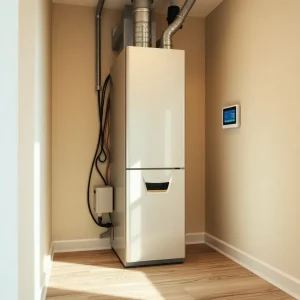A functioning furnace is essential for keeping your home warm and comfortable during the colder months. But what happens when it stops working as it should? From uneven heating to strange noises, furnace problems can quickly turn your cozy home into an uncomfortable space.
The good news? Many common furnace problems have straightforward fixes you can tackle yourself or with minimal professional help.
In this guide, you will learn about the most common furnace problems, what might be causing them, and practical steps to get your system back in top shape—before the chill sets in. If you’d like our professionals to come over and inspect your furnace, call Direct Home Services at 860-339-6001.
Let’s dive in.
Common Furnace Problems and Fixes
1. Thermostat Issues
The thermostat is the brain of your heating system, communicating when the furnace should start and stop. When something goes wrong with the thermostat, the entire system can fail to function and exhibit the following symptoms:
- Furnace doesn’t turn on
- Inconsistent or incorrect temperature readings
- The furnace cycles on and off too frequently
Common issues include dead batteries, miscalibrated settings, dirt buildup, or faulty wiring.
How to Fix Thermostat Issue?
- Check Power Supply: Ensure the furnace is plugged in, and the breaker hasn’t tripped. Reset if necessary.
- Inspect the Pilot Light/Ignition: For gas furnaces, relight the pilot light or check the electronic ignition.
- Examine the Safety Switch: Ensure the furnace door is securely closed; an open door can trigger the safety switch.
- Check the Thermostat: Confirm it’s set to “Heat” and the temperature is higher than room temp.
2. Furnace Won’t Turn On
If your furnace doesn’t start, the issue might stem from power supply problems, a tripped circuit breaker, a faulty ignition system, or a malfunctioning safety switch.
How to Fix Furnace If It Doesn’t Turn On?
- Check Power Supply: Make sure the furnace is plugged in, and the circuit breaker hasn’t tripped. Reset it if necessary.
- Inspect the Pilot Light/Ignition: For gas furnaces, check if the pilot light is lit. Relight it if it’s gone out, or check for issues with the electronic ignition.
- Examine the Safety Switch: Ensure that the furnace door is securely closed, as an open door can disable the system.

3. Furnace Blowing Cold Air
If your furnace is running but blowing cold air, it can be due to:
- Incorrect thermostat settings
- Dirty air filters
- Extinguished pilot lights
- Low gas supply
- Malfunctioning heat exchanger.
How to Fix Furnace if Its Blowing Cold Air?
- Check the Thermostat: Confirm it is set to “Auto” or “Heat” mode and that the temperature setting is higher than the current room temperature.
- Replace Air Filters: Blocked or dirty filters can prevent warm air from circulating. Replace the filter with a clean one.
- Inspect the Pilot Light: If the pilot light is out, relight it following your furnace’s manual instructions. For electronic ignitions, ensure the system is functioning.
- Verify Fuel Supply: For gas furnaces, check that the gas valve is open. If you use an oil furnace, ensure the tank has fuel.
4. Uneven Heating
Uneven heating can leave certain areas of your home cold while others are overly warm, creating discomfort and frustration for your family. This issue is often caused by blocked vents, leaky or uninsulated ductwork, poor airflow, or an improperly sized furnace.
How to Fix Uneven Heating
- Check Air Vents: Make sure all vents and registers are fully open and free of obstructions like furniture or curtains.
- Seal Ductwork: Use duct tape or mastic sealant to fix any visible gaps or leaks in your duct system.
- Improve Insulation: Add insulation to colder rooms or areas that lose heat quickly.
- Clean Ducts: Dust, dirt, and debris in your ductwork can block airflow. Schedule a duct cleaning if needed.
5. Strange Noises Coming from the Furnace
Unusual noises from your furnace, such as banging, squealing, or rattling, are not just annoying but often indicate a mechanical issue that needs attention. Noises can be caused by loose components, dirty burners, a failing blower motor, or worn-out belts. Lack of lubrication in moving parts may also contribute to the noises.
How to Fix Furnace Noises?
- Tighten Panels and Screws: Vibrations can loosen screws or panels, causing rattling. Check for any loose parts and tighten them.
- Clean the Burner: A dirty burner can cause banging or popping sounds. Clean it according to your furnace’s maintenance guide.
- Lubricate the Motor: If you hear squealing, it may be due to dry or worn blower motor bearings. Lubricate them if recommended by the manufacturer.
- Inspect and Replace Belts: Worn-out belts can create loud squeals. Replace them as needed.
6. Short Cycling (Furnace Turns On and Off Frequently)
When a furnace short cycles, it runs for a few minutes, shuts off, and starts again shortly after. This results in uneven heating and high energy bills. Short cycling is usually caused by dirty air filters, a malfunctioning thermostat, overheating, or an improperly sized furnace.
How to Fix Short Cycling?
- Replace Air Filters: Dirty filters can restrict airflow and cause overheating. Replace them regularly.
- Check Ventilation: Blocked or closed vents can prevent proper airflow, causing the system to cycle frequently.
- Inspect the Flame Sensor: A dirty or faulty flame sensor can cause short cycling. Clean or replace it as needed.
- Recalibrate the Thermostat: Ensure the thermostat is functioning properly and located away from heat sources.
7. Pilot Light Keeps Going Out in Gas Furnace
A pilot light that won’t stay lit is common in gas furnaces and prevents the system from producing heat. This problem can disrupt the furnace’s operation and can be due to:
- A dirty or faulty thermocouple
- A draft near the furnace
- Low gas pressure
- A clogged or dirty pilot orifice
How to Fix a Pilot Light That Keeps Going Out?
- Clean or Replace the Thermocouple: The thermocouple may fail to detect the pilot light if it’s dirty or damaged. Clean it gently with sandpaper or replace it if needed.
- Seal Drafts: Inspect the area around the furnace for drafts that could extinguish the pilot light. Seal gaps around doors, windows, or the furnace itself.
- Check Gas Supply: Ensure the gas valve is fully open, and verify the gas pressure with your utility provider if the issue persists.
- Clean the Pilot Orifice: A clogged pilot orifice can prevent a steady flame. Use a needle or compressed air to clear any blockages.
8. High Energy Bills Without Increased Furnace Usage
A sudden spike in your energy bills without a corresponding increase in furnace usage often signals that your furnace is working harder than necessary due to inefficiencies. Common causes of this issue include:
- Clogged air filters
- Gaps or cracks in ductwork
- Aging furnace
- Incorrect thermostat setting
How to Fix a Furnace and Prevent High Energy Bills
- Replace Air Filters: Inspect filters monthly and replace them every 1–3 months to maintain proper airflow.
- Seal Ductwork: Use mastic sealant or duct tape to seal any visible leaks in the duct system. For extensive damage, consult a professional.
- Upgrade to a High-Efficiency Furnace: If your furnace is over 15 years old, consider replacing it with an energy-efficient model to lower energy consumption.
- Optimize Thermostat Settings: Program the thermostat to lower temperatures when heating is less critical, such as when you’re asleep or away.
9. Overheating Furnace
An overheating furnace can pose serious risks, including system breakdowns or fire hazards. This issue is often a sign of airflow restrictions or mechanical malfunctions due to:
- Dirty air filters
- Blocked vents or registers
- Faulty blower motor
- Cracked heat exchanger
- Improper ventilation
How to Fix an Overheating Furnace
- Replace Dirty Filters: Inspect and replace air filters monthly to maintain proper airflow.
- Unblock Vents and Registers: Ensure all vents are open and free of obstructions like furniture, curtains, or debris.
- Inspect the Blower Motor: Check for strange noises or poor airflow. Lubricate the motor or replace it if necessary.
- Check for Cracks in the Heat Exchanger: If you suspect a cracked heat exchanger, turn off the furnace and call a professional immediately to inspect and repair it.
- Improve Ventilation: Clear the area around the furnace to promote proper airflow and prevent overheating.
When to Call a Professional to Fix Furnace?
While some furnace problems can be resolved with simple troubleshooting, others require the expertise of a professional to ensure safety and proper repairs.
Here are the signs that it’s time to call in an HVAC technician:
- Frequent Pilot Light Outages: Persistent issues with relighting the pilot light in gas furnaces.
- Unusual Noises: Banging, squealing, or rattling sounds that don’t resolve after basic troubleshooting.
- Inconsistent Heating: Uneven temperatures throughout your home despite clear vents and filters.
- Short Cycling: The furnace frequently turns on and off in short intervals.
- High Energy Bills: A significant increase in energy usage without changes in your heating habits.
- Persistent Overheating: The furnace shuts down due to excessive heat or you notice a burning smell.
- Carbon Monoxide Alerts: If a detector signals a leak, shut off the furnace and call for immediate assistance.
- Faulty Ignition System: For gas furnaces, if the electronic ignition repeatedly fails.
- Thermostat Problems: If the thermostat doesn’t respond to adjustments or gives incorrect readings.
- No Heat at All: When the furnace won’t turn on after checking the power supply and basic troubleshooting.
Continuing to operate a malfunctioning furnace or attempting DIY repairs for complex problems can put your home and family at risk. If you are unsure about the problem with your furnace, it is advisable to call a licensed HVAC professional to ensure the issue is fixed safely and effectively.
Keep Your Home Warm with Direct Home Services in Connecticut
If you’re experiencing persistent issues with your furnace or need expert advice, trust Direct Home Services to provide reliable solutions. Our team is available 24/7 to handle all your furnace emergencies.
Call 860-339-6001 to schedule a furnace inspection and repair service in Connecticut.
FAQs
What is the most common problem with furnaces?
The most common issue with furnaces is dirty air filters, which restrict airflow and reduce efficiency. Regularly replacing filters can prevent this problem and improve performance.
What fails first on a furnace?
The ignition system or pilot light is often the first component to fail, especially in gas furnaces. This failure can prevent the furnace from starting and producing heat.
What is the most expensive part to fix on a furnace?
The heat exchanger is typically the most expensive part to repair or replace. Its failure often requires significant labor and can cost thousands of dollars, depending on the furnace type.


